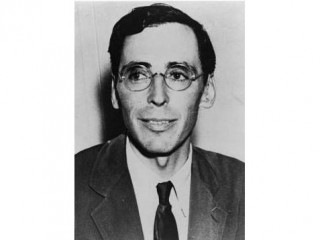
Oliver La Farge biography
Date of birth : 1901-12-19
Date of death : 1963-08-02
Birthplace : New York City,U.S.
Nationality : American
Category : Science and Technology
Last modified : 2011-12-21
Credited as : writer and anthropologist, Pulitzer Prize-winning novel Laughing Boy, The Man With the Calabash Pipe
0 votes so far
La Farge was born in New York City the son of Christopher Grant La Farge and Florence Bayard Lockwood, the niece of Senator Thomas F. Bayard. He was named for his ancestor Oliver Hazard Perry and his uncle, architect Oliver H.P. La Farge I. He received a Bachelor of Arts degree from Harvard University during 1924 and a Master's Degree from the same university in 1929. A member of the university rowing team, he rowed as captain of a men's eight-oared shell.
La Farge, a Newport, Rhode Island New Englander whose grandfather was of French descent and whose other ancestors included English colonists and (allegedly) Narragansett American Indians, was an anthropologist who discovered two previously unknown languages while on scientific expeditions to Central America and the American Southwest. He is well-known for his pioneering visit, with Frans Blom during 1925, to Mexico and what has since become known as the Olmec heartland, (re)discovering San Martin Pajapan Monument 1 and, most importantly, the ruins of La Venta, one of the major Olmec centers.
La Farge also spent much of his adult life championing American Indian rights and was president of the Association on American Indian Affairs for several years.
His published work included several scientific papers and non-fiction books, as well as several novels and a column for the Santa Fe newspaper The New Mexican. Some of his columns were released in book form under the title The Man With the Calabash Pipe.
La Farge had two children by his first wife, heiress Wanden Matthews: a son, Oliver Albee La Farge, and a daughter, Povy; and another son, John Pendaries "Pen" La Farge, by his second wife, Consuelo Baca de La Farge. His 1956 book Behind the Mountains was based on the reminiscences of Consuelo's family, who were ranchers in northern New Mexico. After La Farge and Matthews divorced in 1935, Oliver Albee changed his name to Peter La Farge and became a Greenwich Village folksinger with five Folkways Records albums.
La Farge died in Santa Fe, New Mexico, in 1963.
Works:
-Tribes and Temples (with Frans Blom) 1926-27
-Laughing Boy (1929), novel, the basis for the 1934 motion picture of the same name.
-The Year Bearer's People (with Douglas Byers) 1931
-Introduction to American Indian Art (with John Sloan) 1931
-Sparks Fly Upward (1931), novel.
-Long Pennant, 1933
-All the Young Men (1935), collection of short stories.
-The Enemy Gods (1937), novel.
-An Alphabet for Writing the Navajo Language, 1940
-The Changing Indian (editor) 1942
-The Copper Pot, 1942
-War Below Zero (with Corey Ford and Bernt Balchen) 1944
-Raw Material (1945), a memoir.
-Santa Eulalia: The Religion of a Cuchumatan Indian Town (1947), non-fiction.
-The Eagle in the Egg, 1949
-Cochise of Arizona, 1953
-The Mother Ditch, 1954
-A Pictorial History of the American Indian (1956), non-fiction.
-Behind the Mountains (1956), non-fiction.
-A Pause in the Desert (1957), collection of short stories.
-Santa Fe: The Autobiography of a Southwestern Town (with Arthur N. Morgan) 1959
-The Door in the Wall, 1965
-The Man With the Calabash Pipe (edited by Winfield Townley Scott) 1966
















